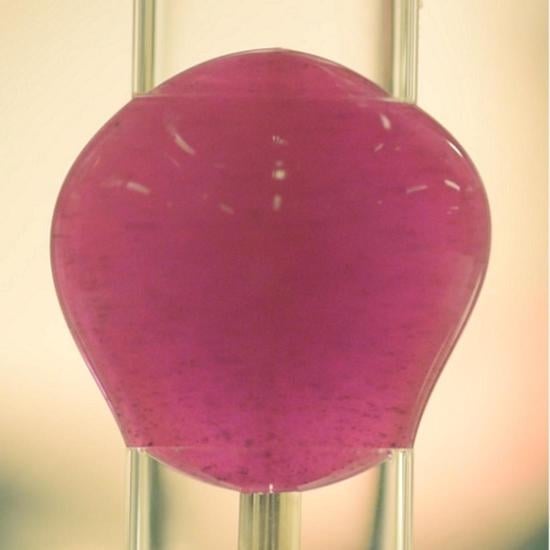Coupling Vortical Bulk Flows to the Air–Water Interface: From Putting Oil on Troubled Waters to Surfactants on Protein Solutions
Abstract
1. Introduction
2. Interfacial Stress Balance
3. Modeling the Non–Newtonian Interfacial Response
4. Two-Way Coupled Flows
5. Marangoni Effects
6. Surface Dilatational Viscosity and Non-Equilibrium Monolayer State
7. Conclusions
Author Contributions
Funding
Institutional Review Board Statement
Informed Consent Statement
Data Availability Statement
Conflicts of Interest
References
- Notter, R.H. Lung Surfactants: Basic Science and Clinical Applications; Lung Biology in Health and Disease; Marcel Dekker: New York, NY, USA, 2000; Volume 149. [Google Scholar]
- Frew, N.M. The role of organic films in air–sea gas exchange. In The Sea Surface and Global Change; Liss, P.S., Duce, R.A., Eds.; Cambridge University Press: Cambridge, UK, 1997; Chapter 5; pp. 121–171. [Google Scholar]
- Tsai, W.T.; Liu, K.K. An assessment of the effect of sea surface surfactant on global atmosphere-ocean CO2 flux. J. Geophys. Res. 2003, 108, 3127. [Google Scholar] [CrossRef]
- Lee, R.J.; Saylor, J.R. The effect of a surfactant monolayer on oxygen transfer across an air/water interface during mixed convection. Int. J. Heat Mass Transf. 2010, 53, 3405–3413. [Google Scholar] [CrossRef]
- Salter, M.E.; Upstill-Goddard, R.C.; Nightingale, P.D.; Archer, S.D.; Blomquist, B.; Ho, D.T.; Huebert, B.; Schlosser, P.; Yang, M. Impact of an artificial surfactant release on air–sea gas fluxes during Deep Ocean Gas Exchange Experiment II. J. Geophys. Res. 2011, 116, C11016. [Google Scholar] [CrossRef]
- Zhang, X.D.; Macosko, C.W.; Davis, H.T.; Nikolov, A.D.; Wasan, D.T. Role of silicone surfactant in flexible polyurethane foam. J. Colloid Interface Sci. 1999, 215, 270–279. [Google Scholar] [CrossRef] [PubMed]
- Snow, S.A.; Pernisz, U.C.; Braun, R.J. “Tying up loose ends”—silicone surfactants as stabilizing agents for flexible polyurethane foam. Silicon Chem. 2005, 3, 1–10. [Google Scholar] [CrossRef]
- Li, J.; Krause, M.E.; Chen, X.; Cheng, Y.; Dai, W.; Hill, J.J.; Huang, M.; Jordan, S.; LaCasse, D.; Narhi, L.; et al. Interfacial Stress in the Development of Biologics: Fundamental Understanding, Current Practice, and Future Perspective. AAPS J. 2019, 21, 44. [Google Scholar] [CrossRef] [PubMed]
- Kuehn, S. Pharmaceutical manufacturing: Current trends and what is next. Chem. Eng. Prog. 2018, 114, 23–29. [Google Scholar]
- Rathore, N.; Rajan, R.S. Current perspectives on stability of protein drug products during formulation, fill and finish operations. Biotechnol. Prog. 2008, 24, 504–514. [Google Scholar] [CrossRef]
- Rathore, N.; Rajan, R.S.; Freund, E. Impact of manufacturing processes on drug product stability and quality. In Formulation and Development Strategies for Manufacturing Biopharmaceuticals; Jameel, F., Hershenson, S., Eds.; John Wiley & Sons: Hoboken, NJ, USA, 2010. [Google Scholar]
- Gikanga, B.; Hui, A.; Maa, Y.F. Mechanistic Investigation on Grinding-Induced Subvisible Particle Formation during Mixing and Filling of Monoclonal Antibody Formulations. PDA J. Pharm. Sci. Tech. 2018, 72, 117–133. [Google Scholar] [CrossRef]
- Nejadnik, M.R.; Randolph, T.W.; Volkin, D.B.; Schöneich, C.; Carpenter, J.F.; Crommelin, D.J.A.; Jiskoot, W. Postproduction Handling and Administration of Protein Pharmaceuticals and Potential Instability Issues. J. Pharm. Sci. 2018, 107, 2013–2019. [Google Scholar] [CrossRef]
- Tryggvason, G.; Scardovelli, R.; Zaleski, S. Direct Numerical Simulations of Gas-Liquid Multiphase Flows; Cambridge University Press: Cambridge, UK, 2011. [Google Scholar]
- Lopez, J.M.; Hirsa, A. Direct determination of the dependence of the surface shear and dilatational viscosities on the thermodynamic state of the interface: Theoretical foundations. J. Colloid Interface Sci. 1998, 206, 231–239. [Google Scholar] [CrossRef]
- Lopez, J.M.; Hirsa, A. Surfactant influenced gas/liquid interfaces: Nonlinear equation of state and finite surface viscosities. J. Colloid Interface Sci. 2000, 229, 575–583. [Google Scholar] [CrossRef] [PubMed]
- Hirsa, A.H.; Lopez, J.M.; Miraghaie, R. Measurement and computation of hydrodynamic coupling at an air/water interface in the presence of an insoluble monolayer. J. Fluid Mech. 2001, 443, 271–292. [Google Scholar] [CrossRef][Green Version]
- Hirsa, A.H.; Lopez, J.M.; Miraghaie, R. Determination of surface shear viscosity via deep-channel flow with inertia. J. Fluid Mech. 2002, 470, 135–149. [Google Scholar] [CrossRef][Green Version]
- Lopez, J.M.; Miraghaie, R.; Hirsa, A.H. Non-Newtonian behavior of an insoluble monolayer: Effects of inertia. J. Colloid Interface Sci. 2002, 248, 103–110. [Google Scholar] [CrossRef][Green Version]
- Miraghaie, R.; Lopez, J.M.; Hirsa, A.H. Flow induced patterning at the air/water interface. Phys. Fluids 2003, 15, L45–L48. [Google Scholar] [CrossRef]
- Vogel, M.J.; Miraghaie, R.; Lopez, J.M.; Hirsa, A.H. Flow-induced patterning of Langmuir monolayers. Langmuir 2004, 20, 5651–5654. [Google Scholar] [CrossRef]
- Hirsa, A.H.; Lopez, J.M.; Vogel, J.M.; Leung, J.F.F. Effects of shearing flow with inertia on monolayer mesoscale structure. Langmuir 2006, 22, 9483–9486. [Google Scholar] [CrossRef]
- Azadani, A.N.; Lopez, J.M.; Hirsa, A.H. Protein crystallization at the air/water interface induced by shearing bulk flow. Langmuir 2007, 23, 5227–5230. [Google Scholar] [CrossRef]
- Azadani, A.N.; Lopez, J.M.; Hirsa, A.H. Coupling between protein-laden films and a shearing bulk flow. J. Colloid Interface Sci. 2008, 322, 79–86. [Google Scholar] [CrossRef]
- Sadoughi, A.H.; Lopez, J.M.; Hirsa, A.H. Transition from Newtonian to non-Newtonian surface shear viscosity of phospholipid monolayers. Phys. Fluids 2013, 25, 032107. [Google Scholar] [CrossRef]
- Lopez, J.M.; Hirsa, A.H. Coupling of the interfacial and bulk flow in knife-edge viscometers. Phys. Fluids 2015, 27, 042102. [Google Scholar] [CrossRef]
- Raghunandan, A.; Lopez, J.M.; Hirsa, A.H. Bulk flow driven by a viscous monolayer. J. Fluid Mech. 2015, 785, 283–300. [Google Scholar] [CrossRef]
- McBride, S.A.; Sanford, S.P.; Lopez, J.M.; Hirsa, A.H. Shear-induced amyloid fibrillization: Role of inertia. Soft Matter 2016, 12, 3461–3467. [Google Scholar] [CrossRef] [PubMed]
- Rasheed, F.; Raghunandan, A.; Hirsa, A.H.; Lopez, J.M. Oscillatory shear rheology measurements and Newtonian modeling of insoluble monolayers. Phys. Rev. Fluids 2017, 2, 044002. [Google Scholar] [CrossRef]
- Balaraj, V.S.; Zeng, P.C.; Sanford, S.P.; McBride, S.A.; Raghunandan, A.; Lopez, J.M.; Hirsa, A.H. Surface shear viscosity as a macroscopic probe of amyloid fibril formation at a fluid interface. Soft Matter 2017, 13, 1780–1787. [Google Scholar] [CrossRef]
- Lopez, J.M.; Hirsa, A. Oscillatory driven cavity with an air/water interface and an insoluble monolayer: Surface viscosity effects. J. Colloid Interface Sci. 2001, 242, 1–5. [Google Scholar] [CrossRef][Green Version]
- Vogel, M.J.; Hirsa, A.H.; Lopez, J.M. Spatio-temporal dynamics of a periodically driven cavity flow. J. Fluid Mech. 2003, 478, 197–226. [Google Scholar] [CrossRef][Green Version]
- Lopez, J.M.; Vogel, M.J.; Hirsa, A.H. Influence of co-existing phases on the surface dilatational viscosity of Langmuir monolayers. Phys. Rev. E 2004, 70, 056308. [Google Scholar] [CrossRef]
- Leung, J.J.F.; Hirsa, A.H.; Blackburn, H.M.; Marques, F.; Lopez, J.M. Three-dimensional modes in a periodically driven elongated cavity. Phys. Rev. E 2005, 71, 026305. [Google Scholar] [CrossRef]
- Underhill, P.; Hirsa, A.H.; Lopez, J.M. Modeling steady shear flows of Newtonian liquids with non-Newtonian interfaces. J. Fluid Mech. 2017, 814, 5–23. [Google Scholar] [CrossRef]
- Raghunandan, A.; Hirsa, A.H.; Underhill, P.T.; Lopez, J.M. Predicting steady shear rheology of condensed-phase monomolecular films at the air-water interface. Phys. Rev. Lett. 2018, 121, 164502. [Google Scholar] [CrossRef] [PubMed]
- Jaensson, N.O.; Anderson, P.D.; Vermant, J. Computational interfacial rheology. J. Non–Newton. Fluid Mech. 2021, 290, 104507. [Google Scholar] [CrossRef]
- Patouillet, K.; Davoust, L.; Doche, O.; Delacroix, J. Mannheimer and Schechter model revisited: Viscosimetry of a (non-)Newtonian and curved interface. Phys. Rev. Fluids 2019, 4, 054002. [Google Scholar] [CrossRef]
- Stebe, K.; Lin, S.; Maldaralli, C. Remobilizing surfactant retarded fluid particle interfaces. I. Stress-free conditions at the interfaces of micellar solutions of surfactants with fast adsorption kinetics. Phys. Fluids A 1991, 3, 3–20. [Google Scholar] [CrossRef]
- Chang, C.; Franses, E. Adsorption dynamics of surfactants at the air/water interface: A critical review of mathematical models, data, and mechanisms. Colliods Surfaces A 1995, 100, 1–45. [Google Scholar] [CrossRef]
- Zell, Z.A.; Nowbahar, A.; Mansard, V.; Leal, L.G.; Deshmukh, S.S.; Mecca, J.M.; Tucker, C.J.; Squires, T.M. Surface shear inviscidity of soluble surfactants. Proc. Natl. Acad. Sci. USA 2014, 111, 3677–3682. [Google Scholar] [CrossRef]
- Manikantan, H.; Squires, T. Surfactant dynamics: Hidden variables controlling fluid flows. J. Fluid Mech. 2020, 100, P1. [Google Scholar] [CrossRef]
- Slattery, J.C.; Sagis, L.; Oh, E.S. Interfacial Transport Phenomena, 2nd ed.; Springer: New York, NY, USA, 2007. [Google Scholar]
- Scriven, L.E. Dynamics of a fluid interface. Chem. Engng. Sci. 1960, 12, 98–108. [Google Scholar] [CrossRef]
- Chen, J. Hydrodynamic Coupling between a Viscoelastic Gas/Liquid Interface and a Swirling Vortex Flow. Ph.D. Thesis, The Pennsylvania State University, State College, PA, USA, 1998. [Google Scholar]
- Lopez, J.M.; Chen, J. Coupling between a viscoelastic gas/liquid interface and a swirling vortex flow. J. Fluids Eng. 1998, 120, 655–661. [Google Scholar] [CrossRef]
- Jiang, T.S.; Chen, J.D.; Slattery, J.C. Nonlinear interfacial stress-deformation behavior measured with several interfacial viscometers. J. Colloid Interface Sci. 1983, 96, 7–19. [Google Scholar] [CrossRef]
- Vogel, M.J.; Hirsa, A.H. Concentration measurements downstream of an insoluble monolayer front. J. Fluid Mech. 2002, 472, 283–305. [Google Scholar] [CrossRef]
- Espinosa, G.; López-Montero, I.; Monroy, F.; Langevin, D. Shear rheology of lipid monolayers and insights on membrane fluidity. Proc. Natl. Acad. Sci. USA 2011, 108, 6008–6013. [Google Scholar] [CrossRef] [PubMed]
- Hirsa, A.; Harper, J.E.; Kim, S. Columnar vortex generation and interaction with a clean or contaminated free surface. Phys. Fluids 1995, 7, 2532–2534. [Google Scholar] [CrossRef]
- Hirsa, A.; Lopez, J.M.; Kim, S. Evolution of an initially columnar vortex terminating normal to a no-slip wall. Expts. Fluids 2000, 29, 309–321. [Google Scholar] [CrossRef]
- Gulati, S.; Riley, F.P.; Hirsa, A.H.; Lopez, J.M. Flow in a containerless liquid system: Ring-sheared drop with finite surface shear viscosity. Phys. Rev. Fluids 2019, 4, 044006. [Google Scholar] [CrossRef]
- Gulati, S.; Riley, F.P.; Lopez, J.M.; Hirsa, A.H. Mixing within drops via surface shear viscosity. Int. J. Heat Mass Transf. 2018, 125, 559–568. [Google Scholar] [CrossRef]
- McMackin, P.M.; Griffin, S.R.; Riley, F.P.; Gulati, S.; Debono, N.E.; Raghunandan, A.; Lopez, J.M.; Hirsa, A.H. Simulated microgravity in the ring-sheared drop. Npj Microgravity 2020, 6, 2. [Google Scholar] [CrossRef]
- Riley, F.P.; McMackin, P.M.; Lopez, J.M.; Hirsa, A.H. Flow in a ring-sheared drop: Drop deformation. Phys. Fluids 2021, 33, 042117. [Google Scholar] [CrossRef]
- Dobson, C. Protein misfolding, evolution and disease. Trends Biochem. Sci. 1999, 24, 329–332. [Google Scholar] [CrossRef]
- Hermans, E.; Vermant, J. Interfacial shear rheology of DPPC under physiologically relevant conditions. Soft Matter 2014, 10, 175–186. [Google Scholar] [CrossRef] [PubMed]
- Sisko, A.W. The flow of lubricating greases. Ind. Eng. Chem. 1958, 50, 1789–1792. [Google Scholar] [CrossRef]
- Neitzel, G.P. Bioreactor fluid dynamics. In Proceedings of the 4th AIAA Theoretical Fluid Mechanics Meeting, Toronto, ON, Canada, 6–9 June 2005. [Google Scholar]
- Dusting, J.; Sheridan, J.; Hourigan, K. A fluid dynamics approach to bioreactor design for cell and tissue culture. Biotechnol. Bioeng. 2006, 94, 1196–1208. [Google Scholar] [CrossRef] [PubMed]
- Spohn, A.; Mory, M.; Hopfinger, E.J. Observations of vortex breakdown in an open cylindrical container with a rotating bottom. Expt. Fluids 1993, 14, 70–77. [Google Scholar] [CrossRef]
- Brons, M.; Voigt, L.K.; Sorensen, J.N. Topology of vortex breakdown bubbles in a cylinder with a rotating bottom and a free surface. J. Fluid Mech. 2001, 428, 133–148. [Google Scholar] [CrossRef]
- Serre, E.; Bontoux, P. Vortex breakdown in a cylinder with a rotating bottom and a flat stress-free surface. Int. J. Heat Fluid Flow 2007, 28, 229–248. [Google Scholar] [CrossRef]
- Cogan, S.J.; Ryan, K.; Sheard, G.J. Symmetry breaking and instability mechanisms in medium depth torsionally driven open cylinder flows. J. Fluid Mech. 2011, 672, 521–544. [Google Scholar] [CrossRef]
- Yang, W.; Delbende, I.; Fraigneau, Y.; Witkowski, L.M. Axisymmetric rotating flow with free surface in a cylindrical tank. J. Fluid Mech. 2019, 861, 796–814. [Google Scholar] [CrossRef]
- Hirsa, A.H.; Lopez, J.M.; Miraghaie, R. Symmetry breaking to a rotating wave in a lid-driven cylinder with a free surface: Experimental observation. Phys. Fluids 2002, 14, L29–L32. [Google Scholar] [CrossRef]
- Lopez, J.M.; Marques, F.; Hirsa, A.H.; Miraghaie, R. Symmetry breaking in free-surface cylinder flows. J. Fluid Mech. 2004, 502, 99–126. [Google Scholar] [CrossRef]
- Mannheimer, R.J.; Schechter, R.S. An improved apparatus and analysis for surface rheological measurements. J. Colloid Interface Sci. 1970, 32, 195–211. [Google Scholar] [CrossRef]
- Kao, R.L.; Edwards, D.A.; Wasan, D.T.; Chen, E. Measurement of interfacial dilatational viscosity at high rates of interface expansion using the maximum bubble pressure method. I. Gas-liquid surface. J. Colloid Interface Sci. 1992, 148, 247–256. [Google Scholar] [CrossRef]
- Sharp, D.; Eastoe, J. Properties of surfactant monolayers studied by surface light scattering. Langmuir 1996, 12, 2303–2307. [Google Scholar] [CrossRef]
- Peace, S.K.; Richards, R.W. Capillary wave fluctuations of spread films of an amphiphilic graft copolymer at the air-water interface. Polymer 1996, 37, 4945–4951. [Google Scholar] [CrossRef]
- Sharp, D.; Earnshaw, J.C. Surface viscoelastic relation on aqueous solutions of tetradyrofuran. J. Chem. Phys. 1997, 107, 7493–7501. [Google Scholar] [CrossRef]
- Peace, S.K.; Richards, R.W. Surface quasi-elastic light scattering from an amphiphilic graft copolymer at the air-water interface. Langmuir 1998, 14, 667–678. [Google Scholar] [CrossRef]
- Monroy, F.; Giermanska-Kahn, J.; Langevin, D. Dilational viscoelasticity of surfactant monolayers. Colloids Surfaces A Physicochem. Engin. Asp. 1998, 143, 251–260. [Google Scholar] [CrossRef]
- Giermanska-Kahn, J.; Monroy, F.; Langevin, D. Negative effective surface viscosities in insoluble fatty acid monolayers: Effects of phase transition on dilatational viscoelasticity. Phys. Rev. E 1999, 60, 7163–7173. [Google Scholar] [CrossRef]
- Monroy, F.; Giermanska-Kahn, J.; Langevin, D. Anomalous damping of capillary waves with surfactant solutions. J. Non-Equilib. Thermodyn. 2000, 25, 279–299. [Google Scholar] [CrossRef]
- He, P.; Fang, K.; Zou, G.; Peltonen, J.P.K.; Rosenholm, J.B. Elasticity of Langmuir monolayer detected by dynamic oscillation method. Colloids Surfaces A Physicochem. Engin. Asp. 2002, 201, 265–273. [Google Scholar] [CrossRef]
- Monroy, F.; Munoz, M.G.; Rubio, J.E.F.; Ortega, F.; Rubio, R.G. Capillary waves in ionic surfactant solutions: Effects of the electrostatic adsorption barrier and analysis in terms of a new dispersion equation. J. Phys. Chem. B 2002, 106, 5636–5644. [Google Scholar] [CrossRef]
- Buzza, D.M.A.; Jones, J.L.; McLeish, T.C.B.; Richards, R.W. Theory of surface light scattering from a fluid-fluid interface with adsorbed polymeric surfactants. J. Chem. Phys. 1998, 109, 5008–5024. [Google Scholar] [CrossRef]
- Noskov, B.A.; Loglio, G. Dynamic surface elasticity of surfactant solutions. Colloids Surf. A Physicochem. Engin. Asp. 1998, 143, 167–183. [Google Scholar] [CrossRef]
- Munoz, M.G.; Monroy, F.; Hernandez, P.; Ortega, F.; Rubio, R.G.; Langevin, D. Anomalous damping of the capillary waves at the air-water interface of a soluble triblock copolymer. Langmuir 2003, 19, 2147–2154. [Google Scholar] [CrossRef]
- Alonso, C.; Waring, A.; Zasadzinski, J.A. Keeping lung surfactant where it belongs: Protein regulation of two-dimensional viscosity. Biophys. J. 2005, 89, 266–273. [Google Scholar] [CrossRef]
- Sagis, L.M.C. Dynamic properties of interfaces in soft matter: Experiments and theory. Rev. Mod. Phys. 2011, 83, 1367–1403. [Google Scholar] [CrossRef]
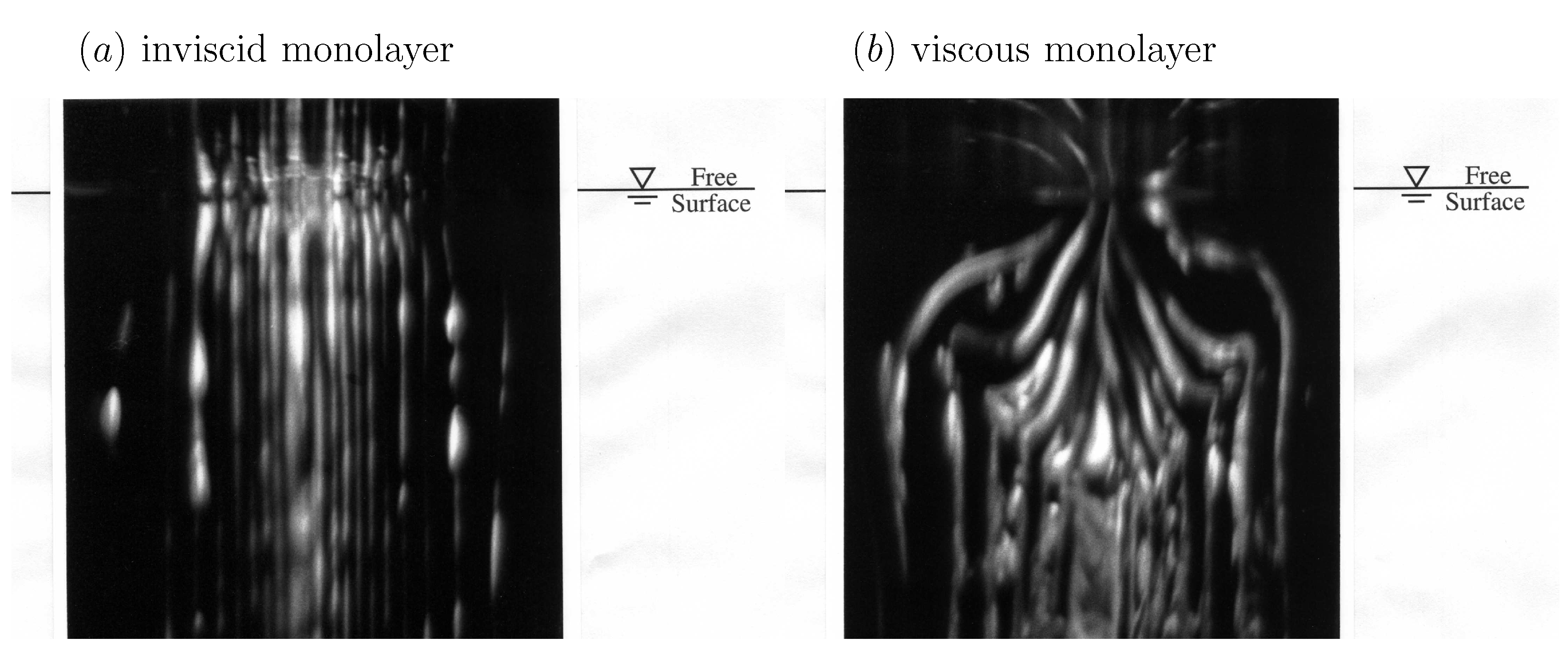
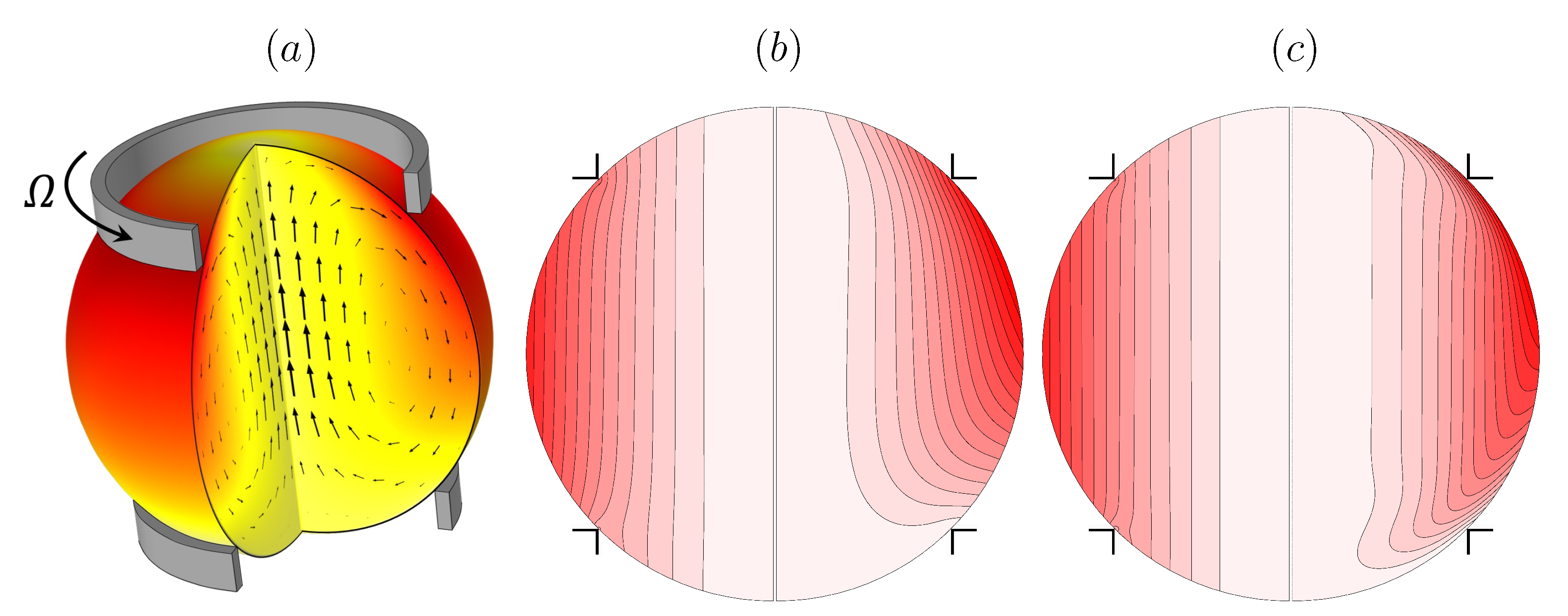



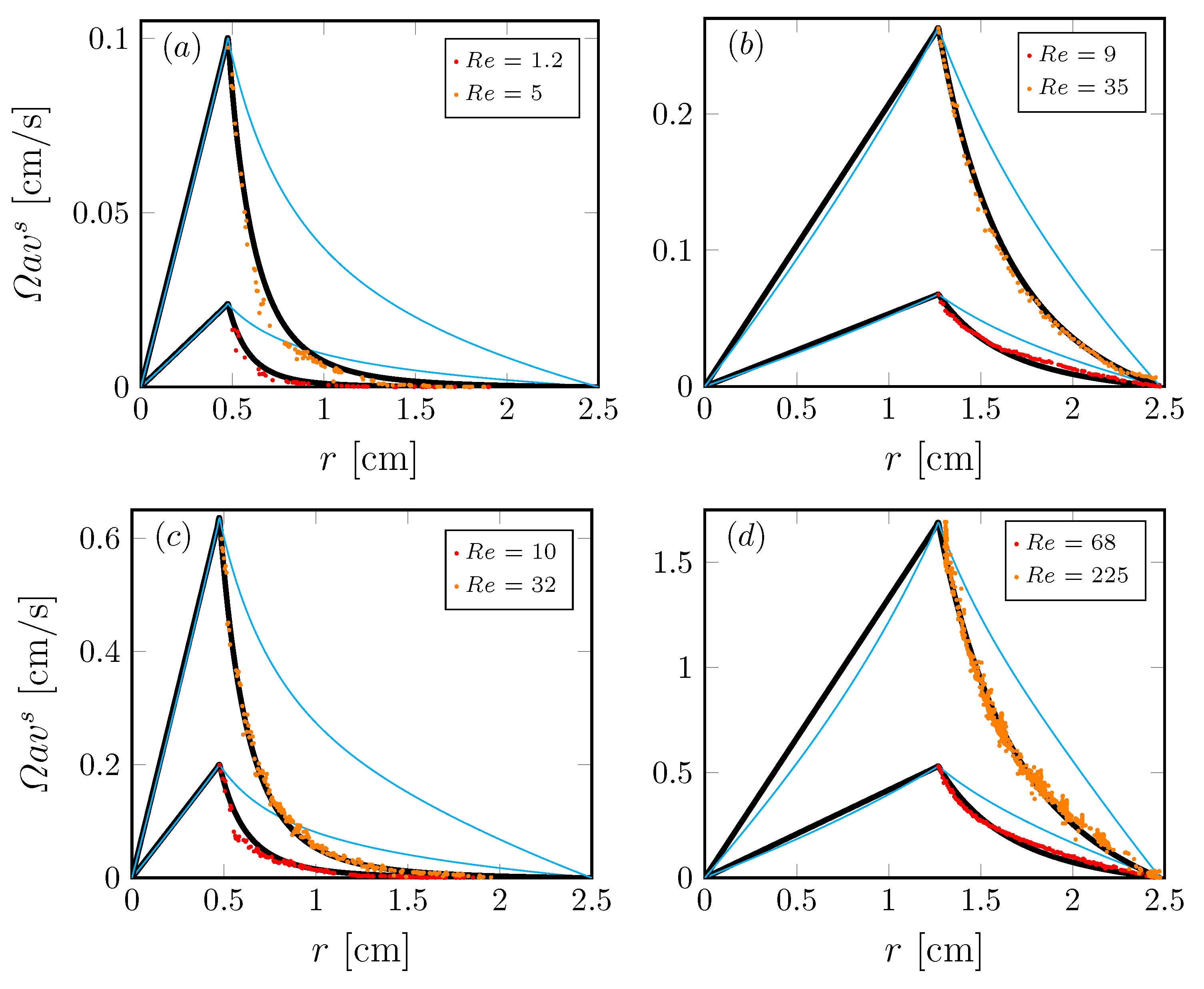


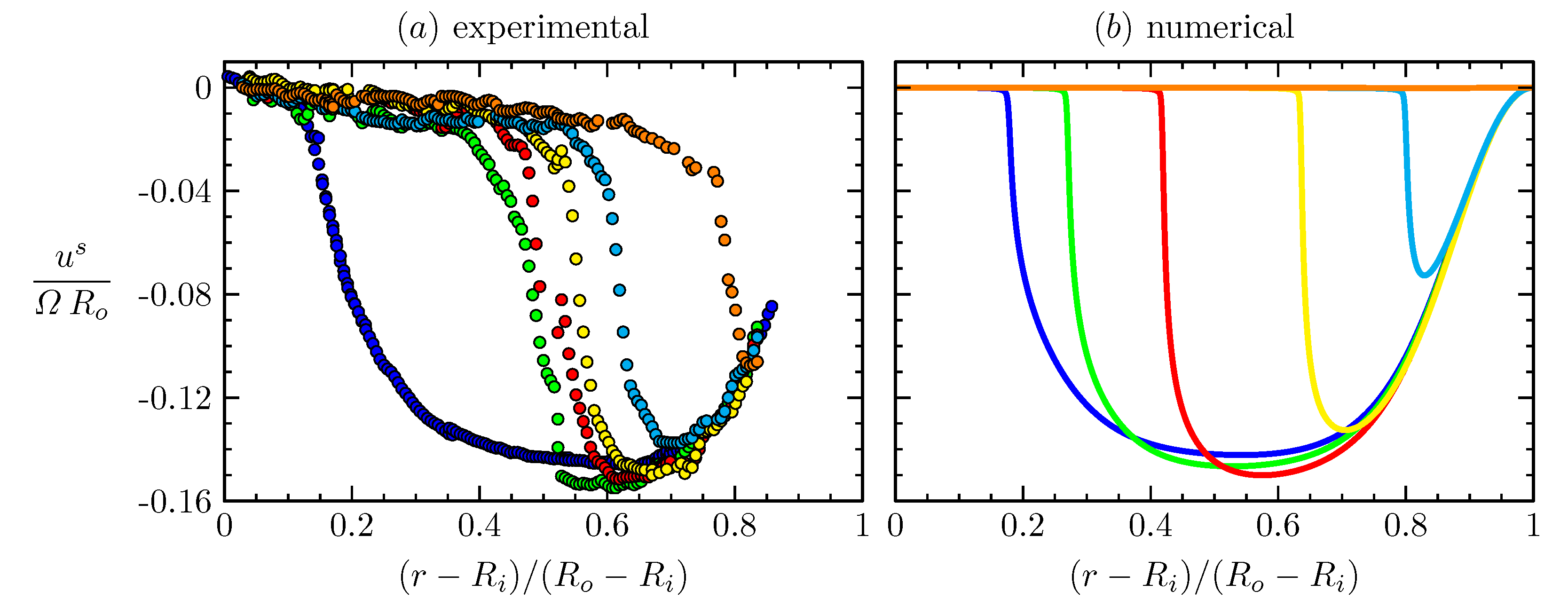
Publisher’s Note: MDPI stays neutral with regard to jurisdictional claims in published maps and institutional affiliations. |
© 2021 by the authors. Licensee MDPI, Basel, Switzerland. This article is an open access article distributed under the terms and conditions of the Creative Commons Attribution (CC BY) license (https://creativecommons.org/licenses/by/4.0/).
Share and Cite
Hirsa, A.H.; Lopez, J.M. Coupling Vortical Bulk Flows to the Air–Water Interface: From Putting Oil on Troubled Waters to Surfactants on Protein Solutions. Fluids 2021, 6, 198. https://doi.org/10.3390/fluids6060198
Hirsa AH, Lopez JM. Coupling Vortical Bulk Flows to the Air–Water Interface: From Putting Oil on Troubled Waters to Surfactants on Protein Solutions. Fluids. 2021; 6(6):198. https://doi.org/10.3390/fluids6060198
Chicago/Turabian StyleHirsa, Amir H., and Juan M. Lopez. 2021. "Coupling Vortical Bulk Flows to the Air–Water Interface: From Putting Oil on Troubled Waters to Surfactants on Protein Solutions" Fluids 6, no. 6: 198. https://doi.org/10.3390/fluids6060198
APA StyleHirsa, A. H., & Lopez, J. M. (2021). Coupling Vortical Bulk Flows to the Air–Water Interface: From Putting Oil on Troubled Waters to Surfactants on Protein Solutions. Fluids, 6(6), 198. https://doi.org/10.3390/fluids6060198




